Epithelial-Myeloid cell crosstalk regulates acinar cell plasticity and pancreatic remodeling in mice
- PMID: 28980940
- PMCID: PMC5690281
- DOI: 10.7554/eLife.27388
Epithelial-Myeloid cell crosstalk regulates acinar cell plasticity and pancreatic remodeling in mice
Abstract
Dedifferentiation of acini to duct-like cells occurs during the physiologic damage response in the pancreas, but this process can be co-opted by oncogenic Kras to drive carcinogenesis. Myeloid cells infiltrate the pancreas during the onset of pancreatic cancer, and promote carcinogenesis. Here, we show that the function of infiltrating myeloid cells is regulated by oncogenic Kras expressed in epithelial cells. In the presence of oncogenic Kras, myeloid cells promote acinar dedifferentiation and carcinogenesis. Upon inactivation of oncogenic Kras, myeloid cells promote re-differentiation of acinar cells, remodeling of the fibrotic stroma and tissue repair. Intriguingly, both aspects of myeloid cell activity depend, at least in part, on activation of EGFR/MAPK signaling, with different subsets of ligands and receptors in different target cells promoting carcinogenesis or repair, respectively. Thus, the cross-talk between epithelial cells and infiltrating myeloid cells determines the balance between tissue repair and carcinogenesis in the pancreas.
Keywords: EGF; MAPK; cancer biology; mouse; myeloid cell; pancreatic cancer; signaling pathways; tissue remodeling.
Conflict of interest statement
No competing interests declared.
Figures
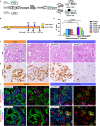
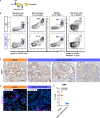
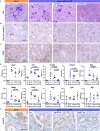
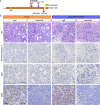
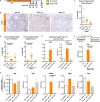

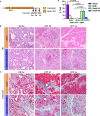
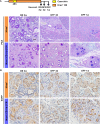
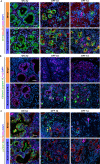


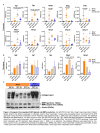

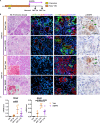
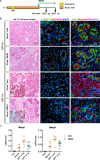

Similar articles
-
Nicotine promotes initiation and progression of KRAS-induced pancreatic cancer via Gata6-dependent dedifferentiation of acinar cells in mice.Gastroenterology. 2014 Nov;147(5):1119-33.e4. doi: 10.1053/j.gastro.2014.08.002. Epub 2014 Aug 12. Gastroenterology. 2014. PMID: 25127677
-
MAPK signaling is required for dedifferentiation of acinar cells and development of pancreatic intraepithelial neoplasia in mice.Gastroenterology. 2014 Mar;146(3):822-834.e7. doi: 10.1053/j.gastro.2013.11.052. Epub 2013 Dec 6. Gastroenterology. 2014. PMID: 24315826 Free PMC article.
-
Dynamic Regulation of Expression of KRAS and Its Effectors Determines the Ability to Initiate Tumorigenesis in Pancreatic Acinar Cells.Cancer Res. 2021 May 15;81(10):2679-2689. doi: 10.1158/0008-5472.CAN-20-2976. Epub 2021 Feb 18. Cancer Res. 2021. PMID: 33602788
-
Oncogenic KRAS and the EGFR loop in pancreatic carcinogenesis-A connection to licensing nodes.Small GTPases. 2018 Nov 2;9(6):457-464. doi: 10.1080/21541248.2016.1262935. Epub 2017 Jan 20. Small GTPases. 2018. PMID: 27880072 Free PMC article. Review.
-
Regeneration and repair of the exocrine pancreas.Annu Rev Physiol. 2015;77:229-49. doi: 10.1146/annurev-physiol-021014-071727. Epub 2014 Oct 24. Annu Rev Physiol. 2015. PMID: 25386992 Free PMC article. Review.
Cited by
-
Using Single Cell Transcriptomics to Elucidate the Myeloid Compartment in Pancreatic Cancer.Front Oncol. 2022 May 19;12:881871. doi: 10.3389/fonc.2022.881871. eCollection 2022. Front Oncol. 2022. PMID: 35664793 Free PMC article. Review.
-
Epithelial memory of inflammation limits tissue damage while promoting pancreatic tumorigenesis.Science. 2021 Sep 17;373(6561):eabj0486. doi: 10.1126/science.abj0486. Epub 2021 Sep 17. Science. 2021. PMID: 34529467 Free PMC article.
-
Cellular determinants and therapeutic implications of inflammation in pancreatic cancer.Pharmacol Ther. 2019 Sep;201:202-213. doi: 10.1016/j.pharmthera.2019.05.012. Epub 2019 May 31. Pharmacol Ther. 2019. PMID: 31158393 Free PMC article. Review.
-
The roles of arginases and arginine in immunity.Nat Rev Immunol. 2025 Apr;25(4):266-284. doi: 10.1038/s41577-024-01098-2. Epub 2024 Oct 17. Nat Rev Immunol. 2025. PMID: 39420221 Review.
-
A reversible epigenetic memory of inflammatory injury controls lineage plasticity and tumor initiation in the mouse pancreas.Dev Cell. 2023 Dec 18;58(24):2959-2973.e7. doi: 10.1016/j.devcel.2023.11.008. Epub 2023 Dec 5. Dev Cell. 2023. PMID: 38056453 Free PMC article.
References
-
- Ardito CM, Grüner BM, Takeuchi KK, Lubeseder-Martellato C, Teichmann N, Mazur PK, Delgiorno KE, Carpenter ES, Halbrook CJ, Hall JC, Pal D, Briel T, Herner A, Trajkovic-Arsic M, Sipos B, Liou GY, Storz P, Murray NR, Threadgill DW, Sibilia M, Washington MK, Wilson CL, Schmid RM, Raines EW, Crawford HC, Siveke JT. EGF receptor is required for KRAS-induced pancreatic tumorigenesis. Cancer Cell. 2012;22:304–317. doi: 10.1016/j.ccr.2012.07.024. - DOI - PMC - PubMed
-
- Bailey P, Chang DK, Nones K, Johns AL, Patch AM, Gingras MC, Miller DK, Christ AN, Bruxner TJ, Quinn MC, Nourse C, Murtaugh LC, Harliwong I, Idrisoglu S, Manning S, Nourbakhsh E, Wani S, Fink L, Holmes O, Chin V, Anderson MJ, Kazakoff S, Leonard C, Newell F, Waddell N, Wood S, Xu Q, Wilson PJ, Cloonan N, Kassahn KS, Taylor D, Quek K, Robertson A, Pantano L, Mincarelli L, Sanchez LN, Evers L, Wu J, Pinese M, Cowley MJ, Jones MD, Colvin EK, Nagrial AM, Humphrey ES, Chantrill LA, Mawson A, Humphris J, Chou A, Pajic M, Scarlett CJ, Pinho AV, Giry-Laterriere M, Rooman I, Samra JS, Kench JG, Lovell JA, Merrett ND, Toon CW, Epari K, Nguyen NQ, Barbour A, Zeps N, Moran-Jones K, Jamieson NB, Graham JS, Duthie F, Oien K, Hair J, Grützmann R, Maitra A, Iacobuzio-Donahue CA, Wolfgang CL, Morgan RA, Lawlor RT, Corbo V, Bassi C, Rusev B, Capelli P, Salvia R, Tortora G, Mukhopadhyay D, Petersen GM, Munzy DM, Fisher WE, Karim SA, Eshleman JR, Hruban RH, Pilarsky C, Morton JP, Sansom OJ, Scarpa A, Musgrove EA, Bailey UM, Hofmann O, Sutherland RL, Wheeler DA, Gill AJ, Gibbs RA, Pearson JV, Waddell N, Biankin AV, Grimmond SM, Australian Pancreatic Cancer Genome Initiative Genomic analyses identify molecular subtypes of pancreatic cancer. Nature. 2016;531:47–52. doi: 10.1038/nature16965. - DOI - PubMed
MeSH terms
Substances
Grants and funding
LinkOut - more resources
Full Text Sources
Other Literature Sources
Medical
Molecular Biology Databases
Research Materials
Miscellaneous

